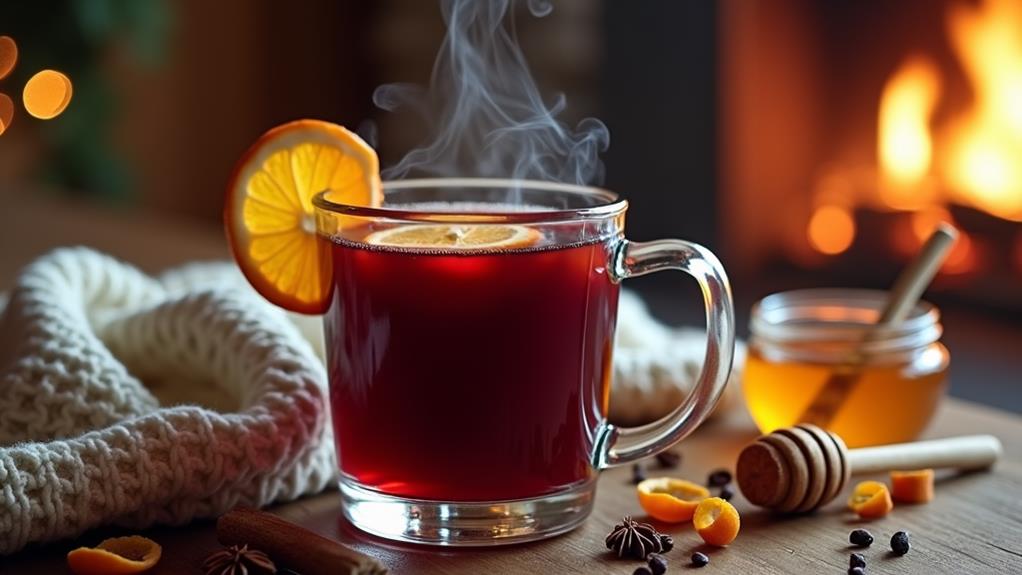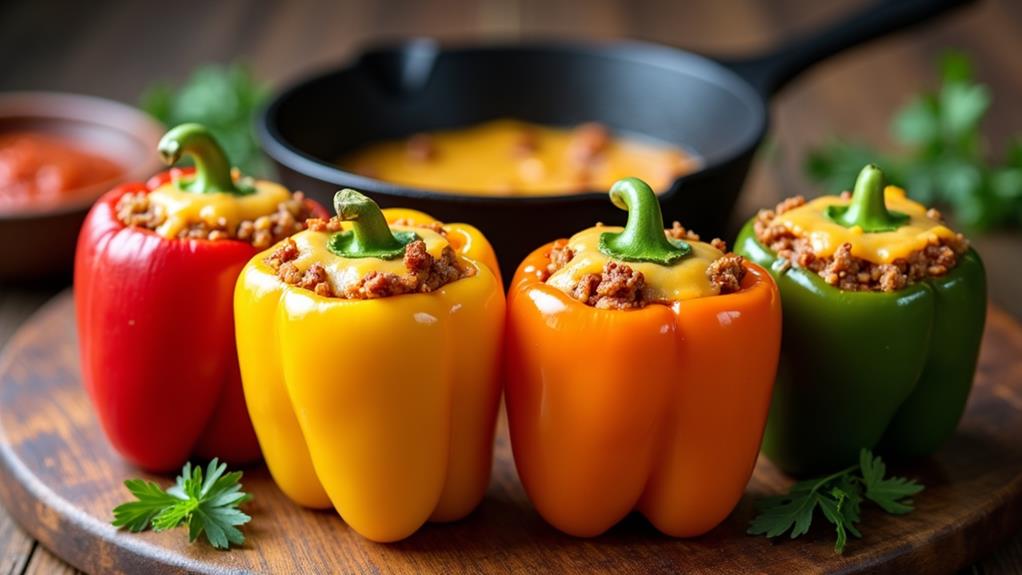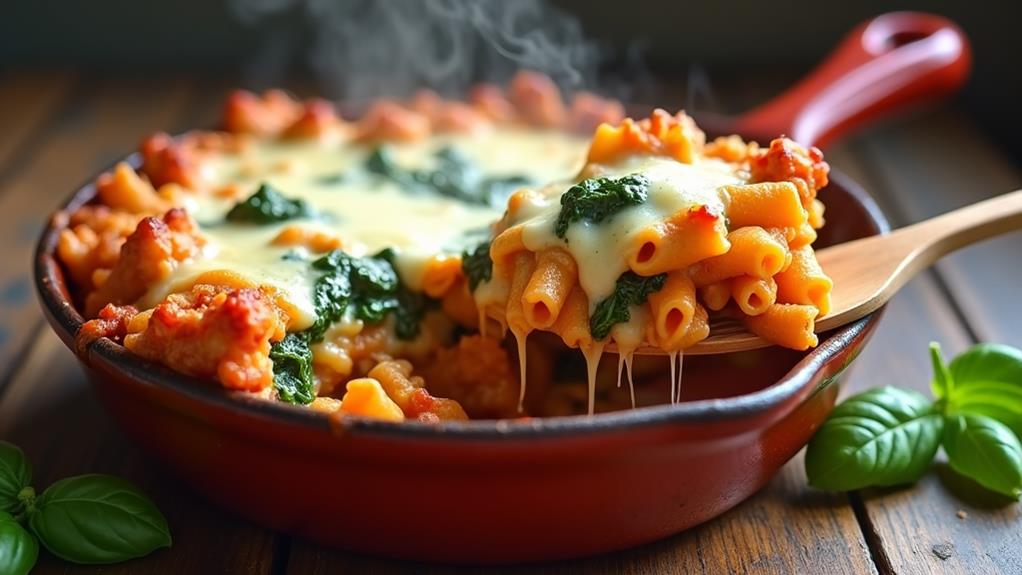You might be surprised to learn that mulled wine, a beloved winter staple, has roots dating back to ancient Rome. This warm, spiced beverage has evolved over centuries, becoming an integral part of holiday traditions across many cultures. While you're likely familiar with its comforting aroma and rich flavor, there's more to mulled wine than meets the eye. From its historical significance to the nuances of its preparation, this festive drink offers a fascinating glimpse into the intersection of culinary arts and cultural heritage. As you explore the world of mulled wine, you'll discover why it's become such an enduring symbol of winter cheer.
Key Takeaways
- Mulled wine is a warm, spiced alcoholic beverage typically made with red wine, citrus, and aromatic spices like cinnamon and cloves.
- It originated in ancient Rome and gained popularity in medieval Europe, becoming a traditional holiday drink in many countries.
- Key ingredients include red wine, orange, cinnamon sticks, cloves, and honey, with optional additions like nutmeg or star anise.
- Preparation involves gently heating the wine with spices and fruit, without boiling, to infuse flavors for about 15 minutes.
- Mulled wine is best served immediately after preparation and pairs well with seasonal snacks or desserts during festive gatherings.
History
The origins of mulled wine can be traced back to ancient Rome. As the Roman Empire expanded, they brought their love for spiced wine to the lands they conquered. This warming beverage quickly gained popularity across Europe, especially in colder regions where it provided comfort during harsh winters.
In medieval times, mulled wine became known as "Hippocras," named after the famous Greek physician Hippocrates. It was believed to have medicinal properties and was often used to ward off illnesses. The drink's popularity continued to grow, and by the 14th century, it had become a staple at European wintertime gatherings and festivals.
You'll find that each country has developed its own unique version of mulled wine over the centuries. In Germany, it's called "Glühwein," while in Scandinavia, it's known as "Glögg." The British have their own variation called "Wassail," which is traditionally associated with Christmas and New Year's celebrations.
Today, you can enjoy mulled wine at Christmas markets throughout Europe, where it's served in festive mugs and has become an integral part of holiday traditions.
Recipe
Mulled wine is a quintessential winter beverage that brings warmth and cheer to any holiday gathering. This aromatic concoction of red wine, citrus, and spices has been enjoyed for centuries, offering a comforting respite from the cold weather.
Our simplified version of mulled wine captures the essence of this classic drink using just five key ingredients. The combination of red wine, orange, cinnamon, cloves, and honey creates a perfect balance of flavors that will fill your home with a comforting, spiced aroma and delight your taste buds.
- 1 bottle (750 ml) dry red wine
- 1 orange
- 2 cinnamon sticks
- 6 whole cloves
- 1/4 cup (60 ml) honey
To prepare the mulled wine, pour the entire bottle of red wine into a large saucepan. Slice the orange into rounds and add them to the wine along with the cinnamon sticks and cloves. Stir in the honey until dissolved.
Heat the mixture over medium-low heat until it's hot but not boiling, which should take about 10-15 minutes. Once heated, reduce the heat to low and let it simmer for an additional 15 minutes to allow the flavors to meld. Strain the mulled wine into mugs or heat-resistant glasses and serve immediately.
For the best results, choose a full-bodied red wine such as Merlot or Cabernet Sauvignon. Be careful not to let the wine boil, as this can cause the alcohol to evaporate and result in a bitter taste.
If you prefer a stronger orange flavor, you can add a splash of orange juice or some orange zest. Leftover mulled wine can be stored in the refrigerator for up to 3 days and reheated gently before serving.
Cooking Steps
To make mulled wine, you'll start by pouring the entire bottle of red wine into a large saucepan.
Next, slice an orange into rounds and add them to the wine, along with cinnamon sticks, cloves, and honey, stirring until the honey dissolves.
Step 1. Pour Wine Into Saucepan
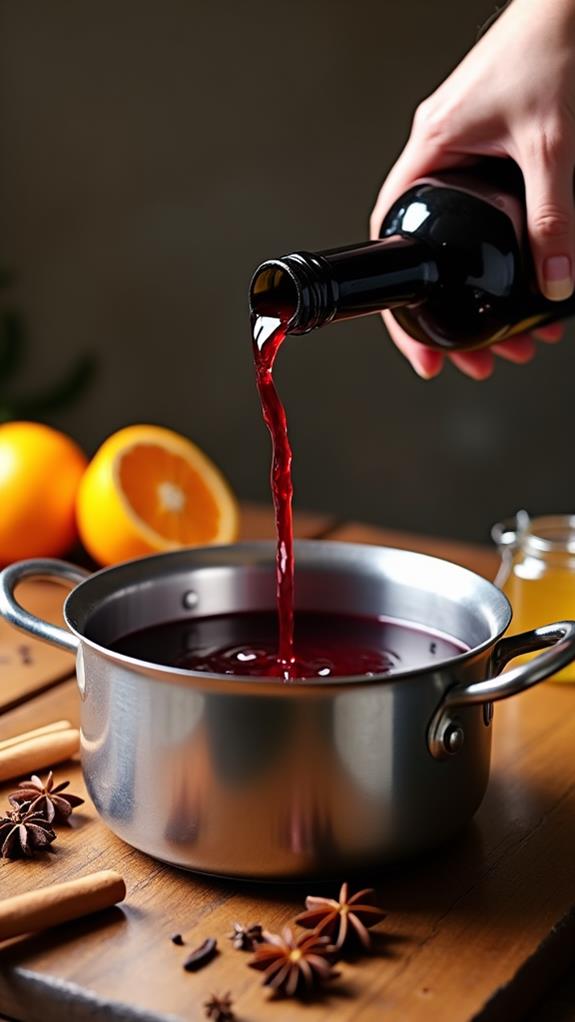
Embarking on your mulled wine journey begins with the simple act of pouring.
Take your chosen bottle of dry red wine, preferably a full-bodied variety like Merlot or Cabernet Sauvignon, and carefully uncork it.
You'll need a large saucepan that can comfortably accommodate the entire 750 ml bottle.
Hold the bottle firmly and tilt it over the saucepan, allowing the rich, ruby-colored liquid to flow smoothly into the pot.
As you pour, you'll notice the wine's aroma filling the air, hinting at the warm, spiced beverage you're about to create.
Make sure you've poured every last drop from the bottle, as this forms the base of your mulled wine.
The saucepan should now contain the full 750 ml of wine, ready for the addition of other ingredients.
It's crucial not to use a smaller pot, as you'll need enough space for the orange slices, cinnamon sticks, and cloves you'll be adding later.
Step 2. Slice and Add Orange
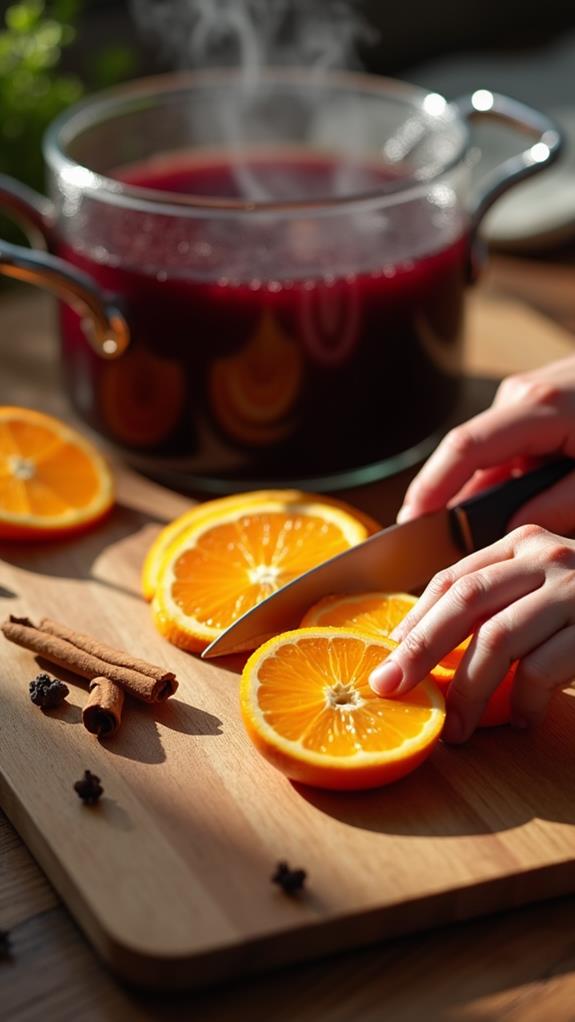
With the wine now in the saucepan, it's time to add a burst of citrus flavor. Take a fresh, whole orange and rinse it thoroughly under cool water to remove any dirt or residue.
Using a sharp knife, carefully slice the orange into rounds about 1/4 inch thick. You'll want to create 6-8 slices, depending on the size of your orange.
As you cut, you'll notice the vibrant orange flesh and the thin, fragrant peel. These slices will infuse your mulled wine with a delightful citrus aroma and subtle sweetness.
Once you've finished slicing, gently drop the orange rounds into the saucepan with the wine. Don't worry if some of the seeds fall in; you'll strain the mixture later.
The orange slices will float on the surface of the wine, releasing their essential oils and flavors as the mixture heats. As they steep, they'll contribute to the complex flavor profile of your mulled wine, complementing the warmth of the spices and the richness of the wine.
Step 3. Add Spices and Honey
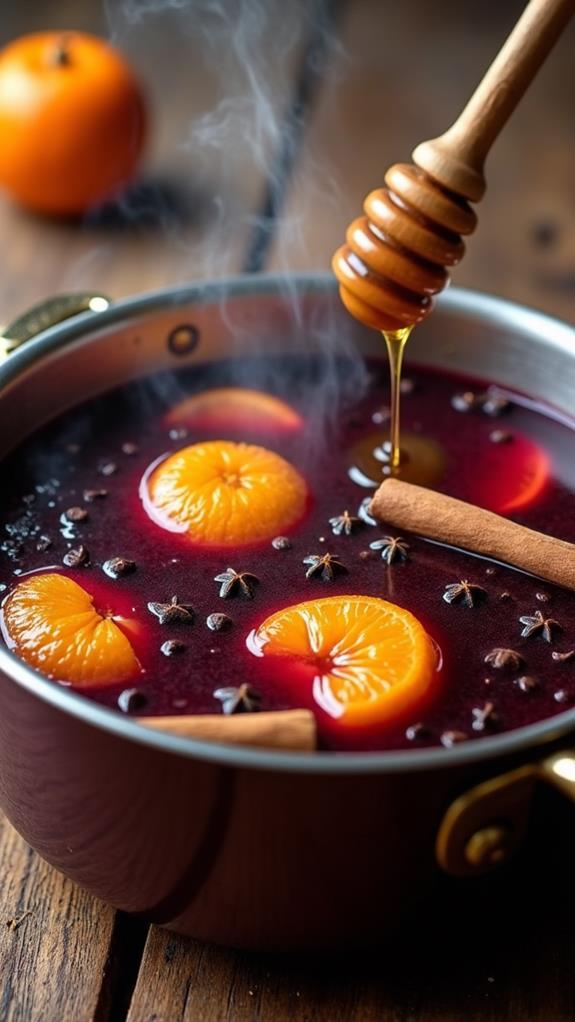
Now that you've added the orange slices, it's time to infuse your mulled wine with warm spices and a touch of sweetness. Grab your cinnamon sticks and gently place them into the saucepan, allowing them to float among the orange slices. These aromatic sticks will impart a rich, woody flavor to your brew.
Next, carefully drop in the whole cloves, which will contribute a subtle, earthy taste and aroma to the mixture. To balance the flavors and add a hint of sweetness, measure out 1/4 cup of honey and pour it into the saucepan.
Using a wooden spoon, stir the mixture gently until the honey has completely dissolved into the wine. This natural sweetener will help mellow any harsh notes from the wine and complement the citrus and spices beautifully.
As you complete this step, you'll notice the enticing aroma of spices beginning to fill your kitchen. The combination of cinnamon, cloves, and honey will create a warm, inviting scent that's quintessential to the mulled wine experience.
With these ingredients added, you're ready to move on to the heating process, where the flavors will truly come together.
Step 4. Heat Until Hot, Not Boiling
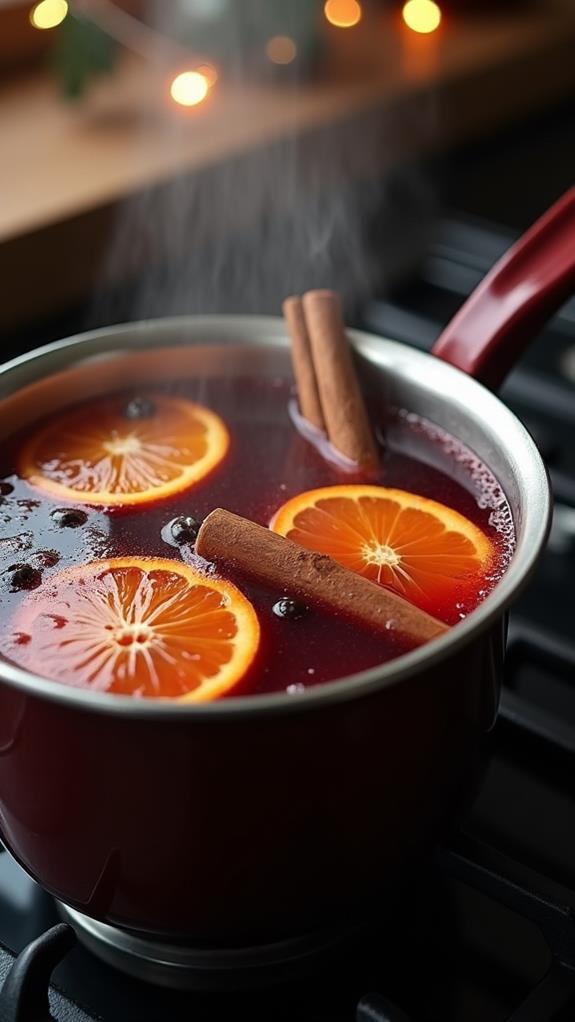
The next crucial step in preparing your mulled wine is to heat the mixture properly.
Place your saucepan containing the wine, spices, and honey over medium-low heat. You'll want to warm the mixture gradually, allowing the flavors to meld and infuse into the wine. It's crucial to keep a close eye on the temperature, as you don't want the wine to boil. Boiling can cause the alcohol to evaporate and may result in a bitter taste.
As you heat the mulled wine, you'll notice the aroma of spices and citrus filling your kitchen. This is a good sign that the flavors are developing nicely.
Use a thermometer if you have one, aiming for a temperature between 140°F and 160°F (60°C to 71°C). If you don't have a thermometer, look for small bubbles forming around the edges of the pan and steam rising from the surface. These are indicators that your mulled wine is reaching the ideal temperature.
Once it's hot enough, reduce the heat to low and let it simmer gently for about 15 minutes to fully develop the flavors.
Step 5. Simmer to Blend Flavors
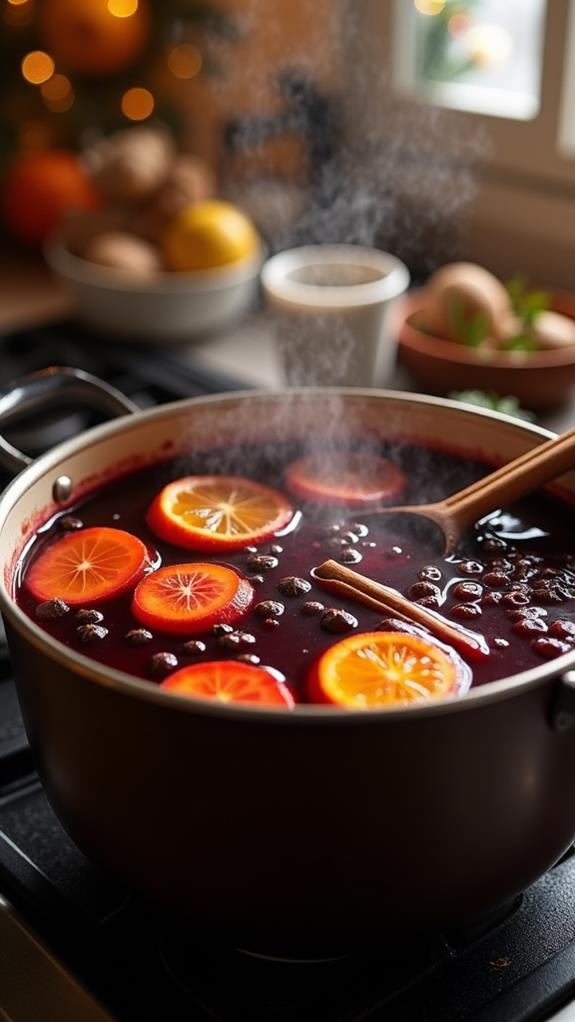
After heating your mulled wine to the proper temperature, it's time to let the flavors meld together. Reduce the heat to low and allow the mixture to simmer gently for about 15 minutes. During this time, you'll notice the aromatic spices infusing the wine with their warm, comforting essence. The orange slices will release their citrusy oils, complementing the rich red wine and honey.
As the mixture simmers, you'll see small bubbles forming around the edges of the pot, but it shouldn't come to a full boil. Stir occasionally to ensure even heat distribution and to prevent any ingredients from sticking to the bottom.
You'll observe the color of the wine deepening slightly as it takes on the hues of the spices. The enticing aroma will fill your kitchen, creating a festive atmosphere. This simmering process is crucial for developing a well-balanced flavor profile, allowing the individual ingredients to harmonize into a cohesive, delicious beverage.
After 15 minutes, your mulled wine will be ready to strain and serve, its flavors perfectly melded and ready to warm you from the inside out.
Final Thoughts
Ultimately, mulled wine is a versatile and forgiving recipe that you can easily customize to suit your taste preferences.
Don't hesitate to experiment with different spices or fruit additions to create your own signature blend. You might try adding star anise for a licorice note, or toss in some cranberries for a tart twist.
If you're serving a crowd, consider making a larger batch in a slow cooker, which will keep the wine warm throughout your gathering.
Remember that quality ingredients make a difference, so choose a wine you'd enjoy drinking on its own.
For a non-alcoholic version, substitute the wine with grape juice or apple cider. You can also adjust the sweetness by varying the amount of honey or using sugar instead.
If you're short on time, pre-made mulling spice mixes are available and can simplify the process.
Whichever method you choose, mulled wine is sure to become a cherished part of your holiday traditions, filling your home with warmth and festive cheer.
Enjoy responsibly and savor the cozy moments it creates.

